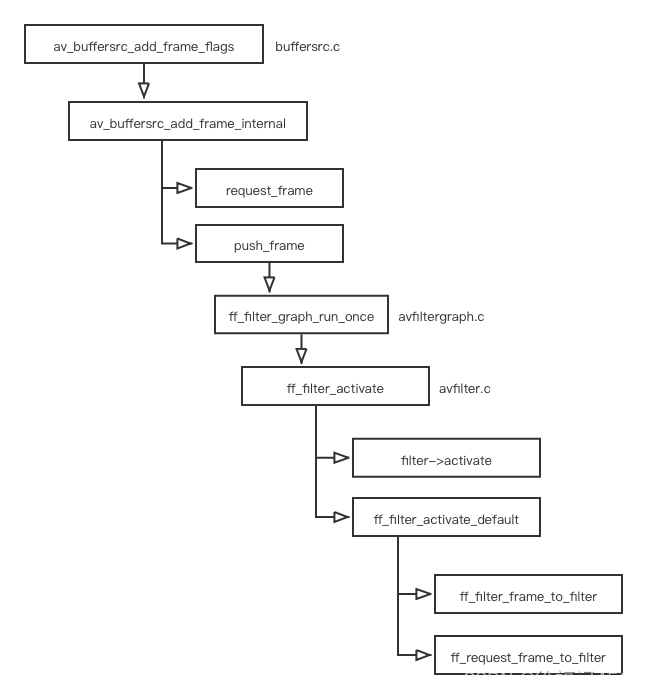FFmpeg在libavfilter模块提供音视频滤镜,而buffersrc与buffersink是连接AVFilter滤镜的桥梁。其中buffersrc是输入缓冲区,buffersink是输出缓冲区。通过调用av_buffersrc_add_frame_flags(),把待滤波的音视频帧推送到输入缓冲区;调用av_buffersink_get_frame_flags()从输出缓冲区取出滤波后的音视频帧。
一、buffersrc
buffersrc是滤波器的输入缓冲区。主要有BufferSourceContext结构体和av_buffersrc_add_frame_flags函数。
1、BufferSourceContext
输入缓存源上下文主要包含视频宽高、像素格式,音频采样率、声道数、声道布局、采样格式,结构体如下:
typedef struct BufferSourceContext {
const AVClass *class;
AVRational time_base;
AVRational frame_rate;
unsigned nb_failed_requests;
/* video only */
int w, h;
AVRational pixel_aspect;
AVBufferRef *hw_frames_ctx;
enum AVPixelFormat pix_fmt;
/* audio only */
int channels;
int sample_rate;
uint64_t channel_layout;
char *channel_layout_str;
enum AVSampleFormat sample_fmt;
int eof;
} BufferSourceContext;
2、av_buffersrc_add_frame_flags
av_buffersrc_add_frame_flags(),向输入缓冲区添加音视频帧,带有flag。其中flag包括不检测格式是否发生变化、立即推送帧到输出队列、保持音视频帧的引用,枚举类型如下:
enum {
// 不检测格式是否发生变化
AV_BUFFERSRC_FLAG_NO_CHECK_FORMAT = 1,
// 立即推送帧到输出队列
AV_BUFFERSRC_FLAG_PUSH = 4,
// 保持音视频帧的引用
AV_BUFFERSRC_FLAG_KEEP_REF = 8
};
与之相似函数是av_buffersrc_add_frame(),默认flag为AV_BUFFERSRC_FLAG_KEEP_REF。调用函数流程如下图所示:

av_buffersrc_add_frame_flags函数位于libavfilter/buffersrc.c,具体源码如下:
int av_buffersrc_add_frame_flags(AVFilterContext *ctx, AVFrame *frame, int flags)
{
BufferSourceContext *s = ctx->priv;
AVFrame *copy;
int refcounted, ret;
if (frame && frame->channel_layout &&
av_get_channel_layout_nb_channels(frame->channel_layout) != frame->channels) {
return AVERROR(EINVAL);
}
s->nb_failed_requests = 0;
if (!frame)
return av_buffersrc_close(ctx, AV_NOPTS_VALUE, flags);
if (s->eof)
return AVERROR(EINVAL);
refcounted = !!frame->buf[0];
if (!(flags & AV_BUFFERSRC_FLAG_NO_CHECK_FORMAT)) {
switch (ctx->outputs[0]->type) {
case AVMEDIA_TYPE_VIDEO:
// 检测视频参数:宽、高、像素格式
CHECK_VIDEO_PARAM_CHANGE(ctx, s, frame->width, frame->height,
frame->format, frame->pts);
break;
case AVMEDIA_TYPE_AUDIO:
if (!frame->channel_layout)
frame->channel_layout = s->channel_layout;
// 检测音频参数:采样格式、采样率、声道布局、声道数
CHECK_AUDIO_PARAM_CHANGE(ctx, s, frame->sample_rate, frame->channel_layout,
frame->channels, frame->format, frame->pts);
break;
default:
return AVERROR(EINVAL);
}
}
if (!(copy = av_frame_alloc()))
return AVERROR(ENOMEM);
if (refcounted && !(flags & AV_BUFFERSRC_FLAG_KEEP_REF)) {
av_frame_move_ref(copy, frame);
} else {
ret = av_frame_ref(copy, frame);
if (ret < 0) {
av_frame_free(©);
return ret;
}
}
// 执行滤波
ret = ff_filter_frame(ctx->outputs[0], copy);
if (ret < 0)
return ret;
// 推送到输出队列
if ((flags & AV_BUFFERSRC_FLAG_PUSH)) {
ret = push_frame(ctx->graph);
if (ret < 0)
return ret;
}
return 0;
}
其中,push_frame()函数只做一件事:调用ff_filter_graph_run_once进行滤波,代码如下:
static int push_frame(AVFilterGraph *graph)
{
int ret;
while (1) {
// 遍历查找滤波器进行滤波
ret = ff_filter_graph_run_once(graph);
if (ret == AVERROR(EAGAIN))
break;
if (ret < 0)
return ret;
}
return 0;
}
而ff_filter_graph_run_once()函数位于avfiltergraph.c,主要是for循环遍历查找滤波器进行滤波:
int ff_filter_graph_run_once(AVFilterGraph *graph)
{
AVFilterContext *filter;
unsigned i;
av_assert0(graph->nb_filters);
filter = graph->filters[0];
for (i = 1; i < graph->nb_filters; i++)
if (graph->filters[i]->ready > filter->ready)
filter = graph->filters[i];
if (!filter->ready)
return AVERROR(EAGAIN);
return ff_filter_activate(filter);
}
二、buffersink
buffersink是滤波器的输出缓冲区。主要有BufferSinkContext结构体和av_buffersink_get_frame_flags函数。
1、BufferSinkContext
输出缓存池上下文主要包含视频像素格式,音频采样率、声道数、声道布局、采样格式,结构体如下:
typedef struct BufferSinkContext {
const AVClass *class;
unsigned warning_limit;
/* only used for video */
enum AVPixelFormat *pixel_fmts;
int pixel_fmts_size;
/* only used for audio */
enum AVSampleFormat *sample_fmts;
int sample_fmts_size;
int64_t *channel_layouts;
int channel_layouts_size;
int *channel_counts;
int channel_counts_size;
int all_channel_counts;
int *sample_rates;
int sample_rates_size;
AVFrame *peeked_frame;
} BufferSinkContext;
2、av_buffersink_get_frame_flags
该函数主要从输出缓冲池取出一帧数据,内部调用get_frame_internal()函数,代码如下:
static int get_frame_internal(AVFilterContext *ctx, AVFrame *frame,
int flags, int samples)
{
BufferSinkContext *buf = ctx->priv;
AVFilterLink *inlink = ctx->inputs[0];
int status, ret;
AVFrame *cur_frame;
int64_t pts;
if (buf->peeked_frame)
return return_or_keep_frame(buf, frame, buf->peeked_frame, flags);
while (1) {
// 获取采样数或帧数据
ret = samples ? ff_inlink_consume_samples(inlink, samples, samples, &cur_frame) :
ff_inlink_consume_frame(inlink, &cur_frame);
if (ret < 0) {
return ret;
} else if (ret) {
return return_or_keep_frame(buf, frame, cur_frame, flags);
} else if (ff_inlink_acknowledge_status(inlink, &status, &pts)) {
return status;
} else if ((flags & AV_BUFFERSINK_FLAG_NO_REQUEST)) {
return AVERROR(EAGAIN);
} else if (inlink->frame_wanted_out) {
ret = ff_filter_graph_run_once(ctx->graph);
if (ret < 0)
return ret;
} else {
ff_inlink_request_frame(inlink);
}
}
}
int av_buffersink_get_frame_flags(AVFilterContext *ctx, AVFrame *frame, int flags)
{
return get_frame_internal(ctx, frame, flags, ctx->inputs[0]->min_samples);
}